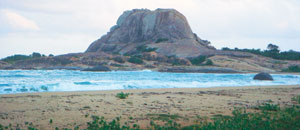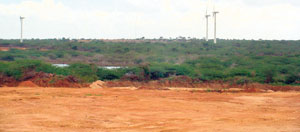My Eurasian grandfather Allanson Duff Lamb called it “Ham- ban- tot” simply because unlike the rest of us he couldn’t pronounce the word “Hambantota”.
Our previous visit was in January 2005 after the devastation of the tsunami.
 Patanangala: The rock standing sentinel and unchanged Patanangala: The rock standing sentinel and unchanged |
The Wild Life and Nature Protection Society bungalow in Yala had been booked way ahead of this tragic event, and we had driven through the night along the Ratnapura road via Embilipitiya, turning towards the coast at “Nonagama” where the statue of poetess “Gajaman Nona” is a notable landmark.
Most of Hambantota was in ruins. In that pre-dawn hour there was this eerie feeling of a place that had seen much destruction and tragedy. There was the unmistakable stench of death mingled with that of stale salt water. Rubble and ruin everywhere. The shell of the mosque with its ceiling fans tortured and twisted but still locked on to the ceiling, is a picture I carry in my mind.
We drove on through silent, seemingly empty streets, of a tented ghost town, where it seemed no one was wakening with the dawn.
This time it was different. Approaching the deep south my heart lifted, as it has done before with a strange affinity to this place. “How come these feelings don’t assail me when we go to all those other places in this country that I also dearly love?” The magic of “Ruhunu Rata” set in. Rippling fields of green paddy, the lotuses in the tanks, the breeze wafting into the van, the fact that all was lush and fresh after rain, the sea almost a constant companion.

Windmills on the horizon: Our own version of the Australian outback |
I forgot the “not nice” episode with the traffic cops at Dickwella, where they insisted we were speeding! To our knowledge there we were munching on just purchased, freshly roasted cadju nuts, and sedately following the van in front! The traffic cop episode necessitated a detour to a private post office whose proprietor was just setting off for Friday prayers. His wife understood our predicament and obliged. The fine paid we had this much needed cooling off with some ice cream. Lovely names re-surfaced -“Ranna”, the turn off to “Angunakolapellessa”, Kirimetiya – where Maureen Seneviratne the author wrote of eating mollusc on the beach. (A sojourn there is in my “some day, some time” file)
“Road closed” – a diversion from the normal approach road to the Town was a disappointment. I felt deprived of seeing the sand dunes we trekked on, to take photographs in my childhood, with a final glimpse of the sea- before the road veered ‘landwards”- to the arid plains and salt flats. Instead, here, now, was a new road, thorn scrub on either side, the thorn bushes clinging tenaciously to life, deep rooted. “Try pulling out even the smallest one!” We saw the signs for the new Harbour, the oil tanks, all construction in progress. A conference facility ! Here ?! “Yes, here!” Windmills – turning in the breeze and one that seemed to have got stuck, in what looks right now like our own version of the Australian outback.
I recommend a visit now, on a “before and after” sojourn. The “before” being work in progress, scar tissue and all. Because after the wounds are healed and landscaping emerges, one is never going to be able to envisage the rawness of the way it was.
We took the turn towards town to where our hotel accommodation and lunch awaited. Here again - changes and reconstruction after the Tsunami. There were some “I wonder if’s”on my part, like the tomb of Engelbrecht in the old cemetery in town. “Did it go under water?” The twirly plinth like tomb of one long gone, is still intact, so maybe it was saved. We didn’t go towards the stretch of road where all those vendors of ‘Kalu Dodol” used to ply their trade. Were they still there ?
The following afternoon Yala beckoned and once again on much loved, familiar territory the floodgates of memory came rushing back. This round yielded a lone elephant at the park entrance, two leopard cubs glimpsed through trees and underbrush – a twitch of an ear here the swish of a tail there, all the while jostling for a decent space to have a look with the other vans and hired Land rovers! Another leopard sighting could best be described as “imagine you saw one” ! The animal was there alright – but one had to use a lot of imagination. Three elephants feeding, again, amongst scrub and thorn and a BABY – a tiny baby “ellie” bonus. Lots of ‘very dear’ Deer, so good to see, because there was a time when their numbers were sorely depleted. A magnificent huge Sambhur seated tranquil and serene beside a water hole, an antler to boot chewing the cud and looking at us, strange species in tiresome metal boxes.
The sad sight of the remains of what was once the Patanangala bungalow. The rock standing sentinel and unchanged over this perfect stretch of beach.
Yala encapsulated it. The mixture of sadness and pathos, the beauty of nature in its varied forms and moods, the past, the ever changing present, and a future of hope that epitomizes – Hambantota.
I’m glad I got a chance to go back ! |

 Patanangala: The rock standing sentinel and unchanged
Patanangala: The rock standing sentinel and unchanged
